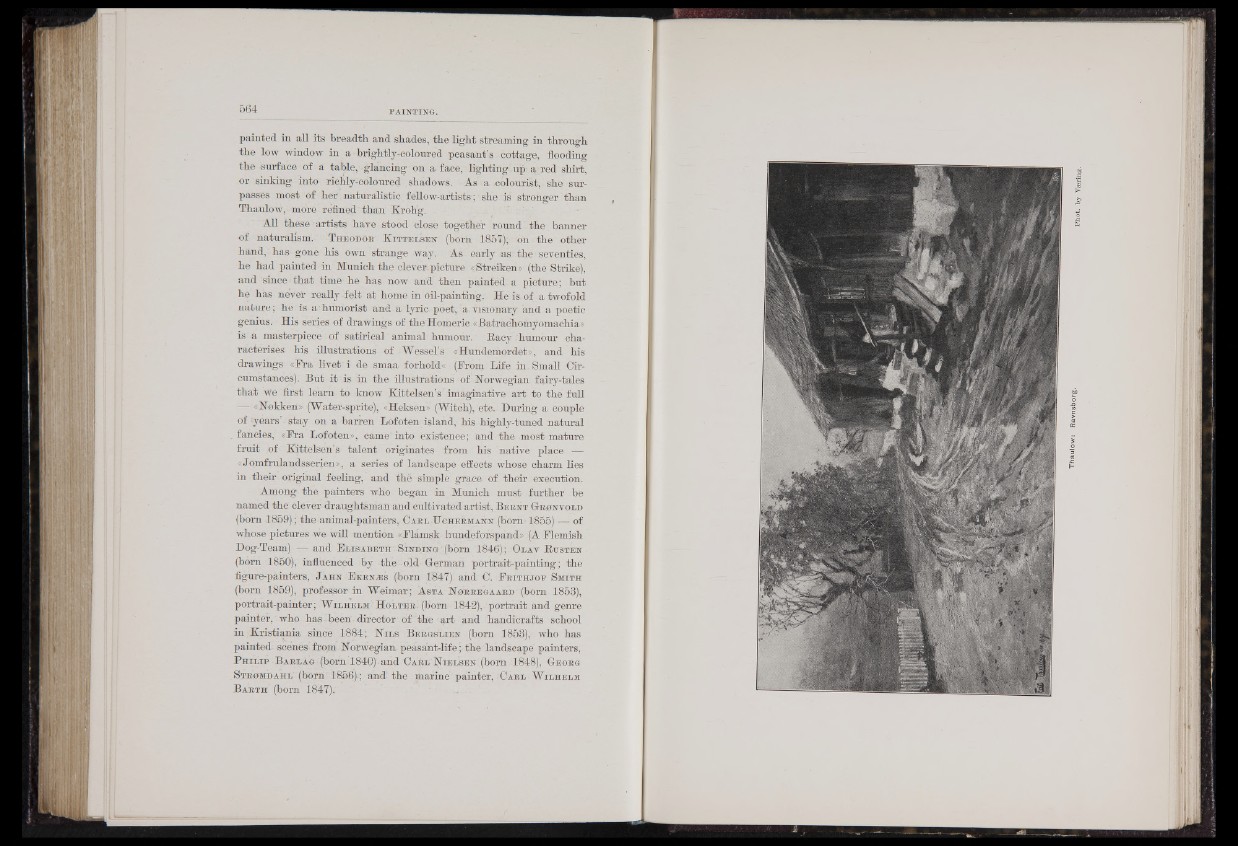
painted in all its breadth, and shades, the light streaming in through
the low window in a-brightly-coloured peasant’s cottage, flooding
the -surface of a table, glancing on a face, lighting.up a red shirt,
or sinking into richly-coloured shadows. As'va colourist, she surpasses
most of her naturalistic fellow-artists; ■ she is stronger than
Thaulow, more refined than Kroh'g.
All these artists have stood close together round the banner
of naturalism. T h e o d o r K i t t e l s e n (born 1857), on the other
hand, has gone his own strange way. As early as the seventies,
he had painted in Munich the eleven picture «Streiken» (the Strike),
and since; that time he has now and then painted a picture; but
he has never really felt at home in oil-painting. He is, of a twofold
nature; he is a humorist and a lyric.poet, a visionary and a poetic
genius. His series of drawings of the Homeric «Batrachomyomachia»
is a masterpiece of satirical animal humour. Bacy .'humour characterises
his illustrations of Wessel’s «Hundemordet», and his
drawings ¿Fra livet'i de smaa forhold« (From Life in Small Circumstances).
But it is in the illustrations of Norwegian fairy-tales
that we first learn to know Kittelsen’s imaginative art to the full
— «Nokken» (Water-sprite), «Heksen» (Witch), etc. During a couple
of iyears’ stay on a barren Lofoten island, his highly-tuned natural
fancies,' «Fra Lofoten», came into existence; and the most mature
fruit of Kittelsen’s talent originates from his native place -—
«Jomfrulandsserien», a series of landscape effects whose charm lies
in their original feeling, and the simple grace of their execution.
Among the painters who began in Munich must further be
named the clever draughtsman and cultivated artist, B e r n t G r o n v o l d
(born 1859); the animal-painters,- C a r l -U c h e r m a n -n (bom 1855) — of
whose pictures we will mention «Flamsk- hundefofspand» (A Flemish
Dog-Team) and E l i s a b e t h S in d i n g ' (born 1846);, O l a v K i : s t k n
(bom 1850), influenced by the-old German portrait-painting; the
figure-painters, J a h n E k e n s e s (born 1847) and C . F r i t h j o f S m i t h
(bom 1859), professor in Weimar; A s t a N o r r e g a a r d (born 1853),
portrait-painter; W i l h e l m H o l t e r ^ (born 184-2), portrait and genre
painter, who has been director of the art and handicrafts school
in Kristiania since 1884; N i l s B b r g s l i e n (bom 1853), who has
painted scenes from Norwegian peasant-life; the landscape painters,
P h i l i p B a r l a g (bom 1840) and C a r l N i e l s e n ’(bom. 1848), G e o r g
S t r o m d a h l ’ (bom 1856}; and the marine painter, C a r l W i l h e l m
E a r t h (bom 1847).